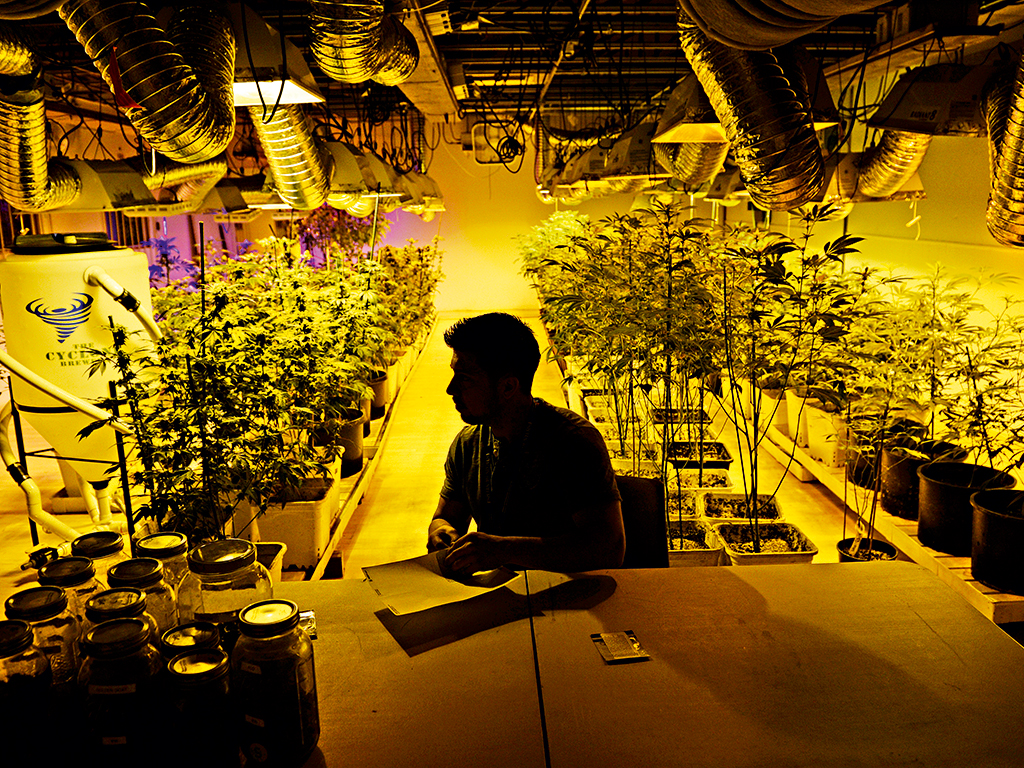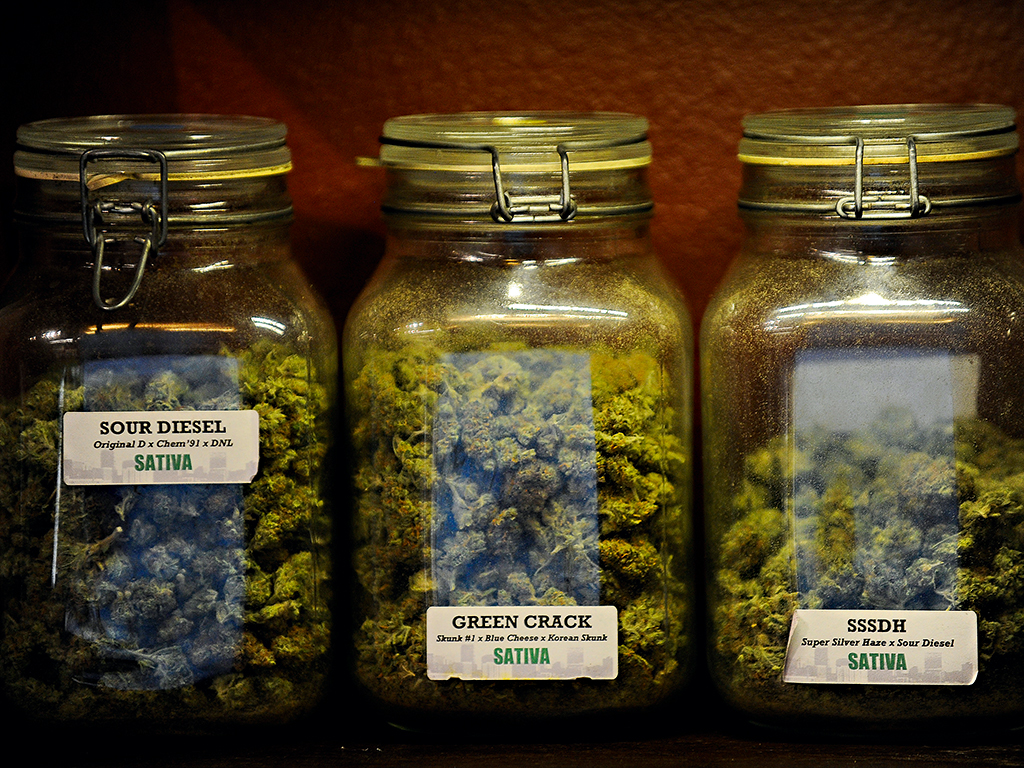Moguls and Mexicans: The American history of cannabis legalisation
Whether you smoke it or not, the history of cannabis in the US is important: it exposes the ignorance, prejudice and hypocrisy that go into lawmaking

A legal grow room at the 3D Cannabis Centre in Colorado. The US has had a complicated relationship with the drug over the years
Medical marijuana is now legal in 22 US states, as well as the District of Columbia; in Colorado, Washington and Alaska, it’s legal to use the drug recreationally. America’s relationship with cannabis has come full circle, from miracle ingredient in patent medicine, through “Assassin of Youth” and threat to Christian virginity, and back again. This demon weed has, in its time, been called an indicator of the ruinous effects of immigration on employment opportunities, been hailed as a vital part of a wartime economy, and brought in $50m in tax revenue. It’s a change in attitudes that can be seen in popular culture, law, and international affairs; a story that takes in presidents, media moguls and Mexican revolutionaries.
Hemp (a high-growing form of cannabis, low in psychoactive constituents) was once a major crop for the fledgling American nation, and remained so up until the Second World War. The fact it could be used to produce a psychoactive drug was almost beside the point (though far from ignored); it was a source of rope and fabric, two important products to the global maritime trade. George Washington and Thomas Jefferson both grew it on their land.
Cannabis (along with heroin, cocaine and morphine) remained legally available in the US
When legislation was brought in to control the use of cannabis around the turn of the last century, it was a recognisable form of business regulation, intended to protect consumers against mislabelled and adulterated pharmaceuticals. While cannabis (along with heroin, cocaine and morphine) remained legally available in the US, the Pure Food and Drug Act of 1906 required that its presence in any measure be clearly labelled – a move intended to combat its use as a secret ingredient in the patent medicines beloved of 19th century salesmen.
As David F Musto, Professor of the History of Medicine at Yale, put it in his book The American Disease: Origins of Narcotic Control: “Not even the reformers claimed, in the pre-World War I hearings and debates over a federal anti-narcotic act, that cannabis was a problem of any major significance in the United States.”
Reefer madness
Real fear of the drug didn’t emerge until the 1920s, when many violent crimes in the southwestern states were attributed to Mexican immigrants and their recreational use of marijuana. This link between cannabis and violent behaviour was actually imported from Mexico itself. As Isaac Campos, author of Home Grown: Marijuana and the Origins of Mexico’s War on Drugs, points out, behaviour resulting from drug use is dependent on one’s psychology and setting. “In Mexico, where virtually everyone believed that marijuana caused madness, and where the drug was used in very violent environments (primarily prisons and soldiers’ barracks), violent reactions and bizarre behaviour appear to have resulted from some cannabis use”, he says. “Once circulating in the United States, these ideas were utilised and elaborated upon by propagandists to secure prohibitionist legislation.”
By 1931, 29 states had outlawed cannabis. The federal government encouraged them to sign up to its Uniform States Narcotic Act, which sought to standardise legal control of drugs across the country. The act was strongly supported by Harry J Anslinger, the first commissioner of the Federal Bureau of Narcotics (FBN). With reported drug cases proliferating, he hoped the states could relieve the FBN of some of the financial burden of pursuing the offenders and allow it to get back to “the hard stuff” (as he called it) of catching heroin smugglers.
Anslinger launched a media campaign designed to put the fear of the demon weed into the American public. He linked the use of ‘reefer’ to violence, murder and sexual promiscuity. He was willing to call on racism, sexism and xenophobia to make his case, while at the same time fabricating figures that ‘showed’ the FBN had successfully driven down rates of drug use where it had combated them. In one typically inflammatory statement, he warned: “There are 100,000 total marijuana users in the US, and most are Negroes, Hispanics, Filipinos and entertainers. Their Satanic music, jazz and swing result from marijuana use. This marijuana causes white women to seek sexual relations with Negroes, entertainers and any others.”
He found support in media baron William Randolph Hearst, whose newspapers dubbed cannabis “the Assassin of Youth”. In 1933, his Los Angeles Examiner warned its readers: “Murder Weed Found Up and Down Coast – Deadly Marihuana [sic] Dope Plant Ready for Harvest That Means Enslavement of California Children”.
Their Satanic music, jazz and swing result from marijuana use
The reasons for Hearst’s particular drive to see cannabis outlawed – if there were any beyond social conservatism and a print baron’s nose for moral outrage – have been much debated. It’s been suggested it was the result of a conspiracy between himself, the wealthy DuPont family and others who feared low-cost hemp fibre would threaten their interests in timber and nylon. However, David Nissen, in his biography of the media baron, points out that, as the owner of a major newsprint organisation already in debt to Canadian suppliers, Hearst could only stand to benefit from a new, cheaper source of paper.
Martin A Lee, in his book Smoke Signals: A Social History of Marijuana – Medical, Recreational, and Scientific, makes the perhaps more astute point that Hearst had “harboured an animus towards Mexicans ever since Pancho Villa occupied [his] 800,000-acre ranch in Chihuahua in 1916 and seized some cattle-grazing land”.
Whatever the truth, Hollywood was soon in on the act, turning out a string of low-budget shockers about the dangers of marijuana. The 1936 exploitation drama Tell Your Children (now better known by its mocking re-release title, Reefer Madness) told a typical tale of various young jazz types being transformed into boggle-eyed murderers by the vile effects of pot. In the words of Lee, the films “epitomised the synchronicity among Washington, Hollywood, and mainstream media in the war against cannabis”.
And it was a war they won. Despite lacking any scientific data to show a correlation between cannabis use and violent crime, Anslinger and his supporters convinced Congress of the drug’s dangers. After holding only two one-hour hearings, Congress passed the Marihuana [sic] Tax Act of 1937. This effectively criminalised cannabis, limiting legal possession to those few who paid excise duty for its medical or industrial use. Not only was the cost of growing hemp now prohibitive, producers were only allowed to produce plants without leaves, buds or flowers – a feat described by one environmental historian as “horticulturally impossible”. The effect of the act, despite Anslinger’s promises, was to wipe out the US domestic hemp industry.

Victory, crackdown and acceptability
Hemp growers enjoyed a brief reprieve during the Second World War; the crop was needed for ship ropes, engine oil and parachutes, and the US Department of Agriculture was happy to pump subsidies into planting more than 300,000 acres of the stuff. True, this so-called ‘ditch weed’ wouldn’t have done much for those looking to get high, but the irony can’t have been lost on the farmers who had seven years earlier been cautioned and reprimanded by Tell Your Children as they filed in to see the 1942 propaganda film Hemp for Victory.
But the reprieve was short-lived. After the war, with supply lines to Asia re-established, US hemp plantations were dug up – though law enforcement officials would spend the next decade or so chasing down the narcotics stemming from these once-legal sites.
The Boggs Act of 1952 and the Narcotics Control Act of 1956 introduced minimum federal sentences for a number of drug-related offences, including the smuggling, sale and possession of cannabis. Nearly 500 people were arrested under the former act on the single night of January 4-5, 1952, while the latter meant a first-time offender found in possession of cannabis could expect to receive a sentence of two to 10 years and a potential fine of $20,000.
Things slackened slightly as cannabis became an emblem of the counter-culture movement
Things slackened slightly in the 1960s as cannabis not only became an emblem of the counter-culture movement, but also found popularity among the white upper-middle classes. Against this relaxed cultural backdrop, Presidents Kennedy and Johnson commissioned fresh reports into the drug’s effects. The Commission on Law Enforcement and Administration of Justice reported in 1967 that the Marihuana Tax Act “raises an insignificant amount of revenue and exposes an insignificant number of marijuana transactions to public view, since only a handful of people are registered under the Act [sic]. It has become, in effect, solely a criminal law, imposing sanctions upon persons who sell, acquire, or possess marijuana”.
In 1969, the US Supreme Court ruled the Marihuana Tax Act was unconstitutional. The following year, Congress passed the Comprehensive Drug Abuse Prevention and Control Act, which repealed the earlier act and classified cannabis separately from other narcotics. In 1972, the National Commission on Marihuana and Drug Abuse found that cannabis possession should be decriminalised. Its report concluded “the actual and potential harm of use of the drug is not great enough to justify intrusion by the criminal law into private behaviour”.
Nation versus state
Though President Nixon rejected the finding of the commission (recognising it went against the mood of Congress), over the decade, Alaska, California, Nebraska, New Mexico, New York, North Carolina, Minnesota, Ohio and Oregon all decriminalised possession, and punishments were relaxed in most other states. In California, an adult found in possession of less than an ounce could now expect no more than a $100 fine, a citation and to have their drugs taken off them.
But federal regulation moved against this growing liberality. Reacting in part to the emergence of powerful conservative parents’ groups, Ronald Reagan signed into law the Anti-Drug Abuse Act, and the Comprehensive Crime Control Act of 1984. While they provided funds for drug education and treatment, the new laws also raised federal penalties for cannabis possession and dealing.
The federal government continued this hard line on drug policy through the ‘tough on crime’ era of the 1980s and 90s. George Bush Sr thought the drug issue “so important, so threatening” that he made it the subject of his first live presidential address, in 1989. While cannabis was not directly named in the speech (Bush instead pointed to the more alarming threats of heroin, crack cocaine and PCP), there can have been no doubt that it stood on the other side of the line he drew in his “War on Drugs”.
Campos points out this language brings with it the popular acceptance that wartime requires sacrifice and the surrendering of traditional rights: “Thus, in the same way that a real war supposedly justifies torture or secret surveillance, declaring war on drugs has helped to justify erosions in civil liberties, imperial forays into foreign countries, the militarisation of domestic police forces, and so forth.”
Democrats’ fear of being labelled soft on crime had been the impetus behind the 1986 law that introduced mandatory minimum sentences for drug offences. That same fear may well have been on President Clinton’s mind as he continued Bush’s crusade. In 1994, he signed the Violent Crime Control and Law Enforcement Act, which increased funding for anti-drug efforts and introduced harsher sentences. Cannabis seizures reached an all-time high in 1999.

Deep breath
All this was in marked contrast to what was happening on a state level. The passing of the Compassionate Care Act in 1996 made California the first state to legalise the sale and purchase of cannabis for medical use. State citizens could now possess up to eight ounces without a doctor’s recommendation, and a system of state-licensed dispensaries was established (though such outlets were not allowed to operate for profit). Federal and state law clashed, and, in 2005, the Supreme Court ruled state law did not prevent Congress outlawing medicinal cannabis.
Despite this, the general mood seemed set that the use of cannabis among adults was no longer a priority concern. The Department of Justice issued new guidelines in 2009 that said: “It will not be a priority to use federal resources to prosecute patients with serious illnesses or their caregivers who are complying with state laws on medical marijuana.”
Between 1996 and 2012, 18 states legalised medical marijuana, and, in 2012, Colorado and Washington became the first to legalise recreational use. Citizens of the former, aged 21 or over, can now buy up to an ounce of marijuana (with a 30 percent tax) from regulated shops and grow up to six plants in their own homes. Far from the outbreaks of crime and debauchery predicted by Anslinger 80 years previously, Slate reported in January 2015 that drug-related crime in Colorado had either remained the same or dropped since the prohibition on recreational cannabis use was lifted.
More importantly, from an economic standpoint, Colorado’s monthly tax revenue from cannabis in the first year of legal sales ($6.5m) was just over a third of what the state made from tobacco ($18.8m) and over 150 percent of what it made from alcohol ($4.5m). “Colorado took in about $53m in tax revenue from sales of recreational marijuana in the last year”, says Sreekar Jasthi, an economic analyst for NerdWallet. While that’s lower than the top-end predictions of over $70m, it’s still enough that, per a 1992 constitutional amendment limiting how much the state can take from tax payers, the Colorado government may now have to refund every adult citizen $7.63.
Colorado’s tax revenue from cannabis was just over a third of what the state made from tobacco
While an end to prohibition does not mean an end to the illegal drugs market – Jasthi points out that “illegal marijuana still costs significantly less than legal pot” – NerdWallet’s analysis suggests the US could gain over $3bn in state and local taxes each year from the federal legalisation of cannabis.
And that’s before factoring in the potential benefit of dropping the prohibition on the growing of hemp. The country’s retail sales of hemp-based products exceed $300m a year, despite the US being the only industrialised nation that does not allow industrial production of the crop. Canadian growers planted an estimated 45,000 acres in 2013, knowing their largest export market would be the US.
In February, Alaska became the third state in which cannabis could be legally purchased for recreational use. Though marijuana legalisation advocates face resistance from some quarters (the Washington-based Safe Streets pressure group is suing Colorado’s governor over the issue, while DEA Special Agent Matt Fairbanks warned Utah’s state senate that rabbits and other animals may become absent minded if allowed to graze on legally grown weed), Jasthi says they “are gaining steam through these bills”.
With similar laws set to come into effect in Oregon and Washington, DC later this year, the US seems in the mood to reconsider its relationship with one of its oldest crops.













